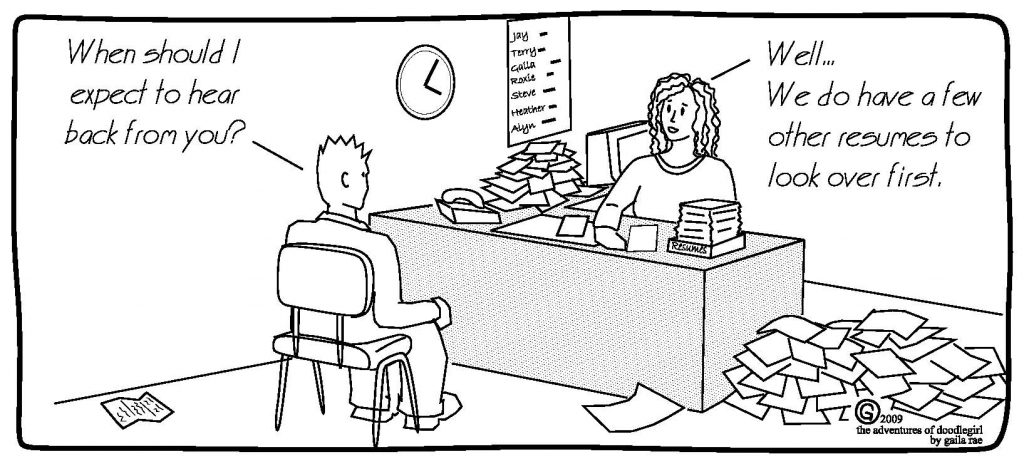 You wrote a brilliant cover letter and handed them a custom-crafted resume and yet they still want you to fill out an application form. What is up with that?
You wrote a brilliant cover letter and handed them a custom-crafted resume and yet they still want you to fill out an application form. What is up with that?
The fact of the matter is that people provide information in resumes differently. It tends to get scattered all over the place and HR people shouldn’t have to dig through every scrap of paper you throw at them in search of the fundamental information they need to fill in employee forms.
“Fill in the complete application. Don’t rely on the recruiter to obtain your information solely from your resume. There may be information requested on the application, like salary history, that would normally not appear on a resume.”
Camille Powers, New York City HR Consultant
Be Completely Truthful on Application
More importantly, the application forms a contract between you and your employer, so that any discrepancies on the form are legal grounds for dismissal. This is why it is important that you provide truthful information, or it will come around to haunt you in the future.
Putting all that aside, what should you always keep in mind while filling in your application form? Let us consider…
Tips for Filling Out Employer Applications
Be Prepared: Bring proper identification. Make sure you have all of the following information—
- Your current address, phone information,
- Driver’s license
- Social Security Number
- Previous employers’ addresses, phone numbers, supervisor names, and copies of any letters of recommendation
Craft it: Just like your resume and cover letter, tune it, to the best of your ability, to reflect the job you’re applying for. If you’re applying for a position in real estate law, don’t forget to mention your time as an Estate Salesperson. Every connection you can make enhances your position and value to the company.
Read: Once you finally have the application in hand, don’t just leap into the form. Read it over first to see where certain information goes. Putting details in inappropriate boxes is a sure fire way to attract attention of the unwanted sort. Treat this as a test of your ability to follow instructions.
If you mess up here, ask yourself, how can they trust you to follow instructions later?
Accuracy: No one expects you to remember the exact dates of hire, the beginning or ending dates of educational courses, or how long you worked for a given employer. Bring a cheat sheet, or work directly off a copy of your resume.
Practice: Obtain a copy of the application form in advance and fill it out at home where you can be leisurely, and do it neatly. Generally, I ask if I can have two copies in the event I make an error. In many cases, it is a downloadable form rather than a tangible object. Ask.
“Be prepared for all kinds of job applications, from simple one-page applications to multi-page applications; and some will be clean and crisp copies while others will appear to be photocopied a few too many times. Regardless, take your time […] always keeping in the back of your mind the goal of the application — getting you an interview.”
Dr. Randall S. Hansen is founder of Quintessential Careers
Be complete: Don’t leave blank spots. If something is not applicable, note that, or fill in N/A. If you don’t fill it in, someone might do so at a later date.
Address Gaps: If you have gaps in your employment history, explain them. Was it surgery, care for an invalid relative? By being upfront about these details you avoid appearing as if you’re hiding something.
Don’t address salary issues: This is far too early for this subject. If they ask on the application about your salary history, simply enter “Negotiable” or “Open”. You need to understand the job first, and then do some research so that you’re prepared with an appropriate number. Some interviewers use this as a screening device and you don’t want to be eliminated because of an answer they happen to disagree with.
Have willing references: Make sure your references are willing to talk to potential employers; you don’t want to blindside them with a phone call from someone they don’t know asking about you. They might misinterpret the call, say “None of your business!” and hang up… Guess where that leaves you…
Identify the Job: Don’t put “any” as an answer or you might end up getting an offer for the mailroom, when you were looking at Regional Director of Sales. Seriously! These HR people are not mind-readers; you can specify multiple positions, if it is appropriate, but have at least one clear job in mind.
Remember to Sign It! You’re thrilled to have gotten through it successfully. Getting everything perfect is such a relief, but make sure you don’t overlook the simplest bit: signing your name. This forms a contract between you and the employer formalizing that you agree to their terms of employment. Missing this important step can show that you are inattentive to details or cannot follow directions. Don’t be that person.
You’re done! Now go get that job!
Cooper & Coon has helped thousands of decision makers and senior executives move up in their careers and achieve significantly improved financial packages within short time frames. Contact Fred Coon or call 866-883-4200, Ext. 200, and connect with them on LinkedIn.